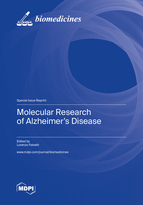Molecular Research of Alzheimer's Disease
A special issue of Biomedicines (ISSN 2227-9059). This special issue belongs to the section "Neurobiology and Clinical Neuroscience".
Deadline for manuscript submissions: closed (15 February 2022) | Viewed by 35006
Special Issue Editor
Interests: critical care medicine; internal medicine; clinical prediction; machine learning and big data analysis; atherosclerosis; Alzheimer's disease; atrial fibrillation; pulmonary embolism; ultrasounds in critical care
Special Issues, Collections and Topics in MDPI journals
Special Issue Information
Dear Colleagues,
Alzheimer’s Disease represents a growing health concern, since ageing demographics are actively contributing to a significant increase in its prevalence and incidence. The classical neuropathogenetic model, based on brain amyloid plaque deposition, neurofibrillary tangles and cholinergic system dysfunction is undergoing reconsideration and integration in light of the failure of both amyloid-targeted and cholinesterase-inhibiting therapies. A better understanding of the relationships between the classical pathogenetic pathways and newer hypotheses are urgently required to guide future research and develop effective drugs. The role of risk factors and comorbidities, such as vascular diseases and diabetes mellitus, as well as neurovascular unit dysfunction, are suggesting the existence of newer molecular mechanisms that could represent potential targets for effective Alzheimer’s Disease treatments. The aim of this Special Issue of Biomedicines is to provide an overview of the pathophysiologic role of newer and older molecular mechanisms of Alzheimer’s Disease and to advance new insights for the development of new therapeutic approaches. Moreover, it will focus on newer candidate markers of disease onset and progression. Both original articles and reviews will be considered for publication in this Special Issue.
Dr. Lorenzo Falsetti
Guest Editor
Manuscript Submission Information
Manuscripts should be submitted online at www.mdpi.com by registering and logging in to this website. Once you are registered, click here to go to the submission form. Manuscripts can be submitted until the deadline. All submissions that pass pre-check are peer-reviewed. Accepted papers will be published continuously in the journal (as soon as accepted) and will be listed together on the special issue website. Research articles, review articles as well as short communications are invited. For planned papers, a title and short abstract (about 100 words) can be sent to the Editorial Office for announcement on this website.
Submitted manuscripts should not have been published previously, nor be under consideration for publication elsewhere (except conference proceedings papers). All manuscripts are thoroughly refereed through a single-blind peer-review process. A guide for authors and other relevant information for submission of manuscripts is available on the Instructions for Authors page. Biomedicines is an international peer-reviewed open access monthly journal published by MDPI.
Please visit the Instructions for Authors page before submitting a manuscript. The Article Processing Charge (APC) for publication in this open access journal is 2600 CHF (Swiss Francs). Submitted papers should be well formatted and use good English. Authors may use MDPI's English editing service prior to publication or during author revisions.
Related Special Issue
- Molecular Research of Alzheimer's Disease 2.0 in Biomedicines (2 articles)







